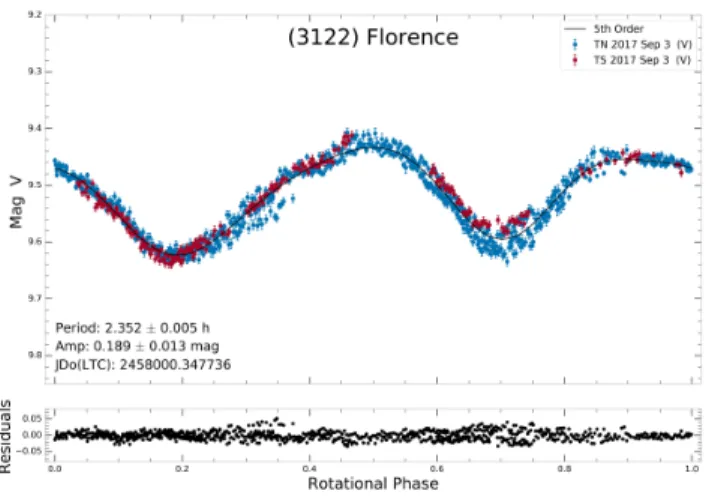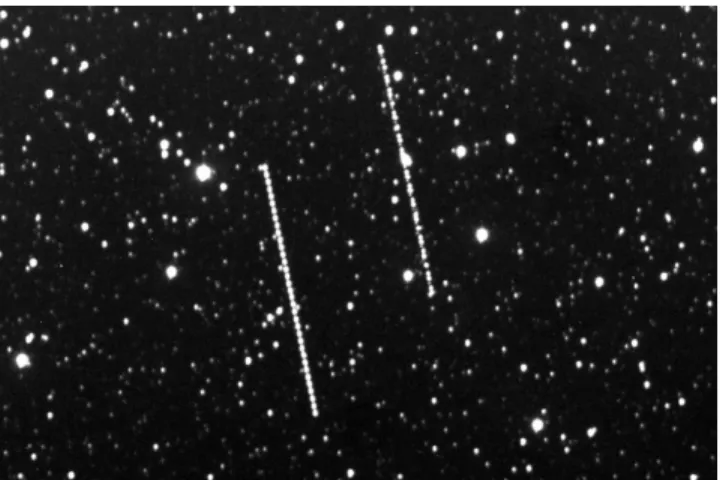1
Minor Planet Bulletin xx (xxxx) TRAPPIST-NORTH AND -SOUTH COMBINED
LIGHTCURVES OF NEAR-EARTH ASTEROID 3122 FLORENCE
Marin Ferrais, Emmanuël Jehin, Youssef Moulane, Francisco J. Pozuelos Space sciences, Technologies & Astrophysics Research (STAR) Institute
University of Liège
Allée du 6 Août 19, 4000 Liège, Belgium m.ferrais@doct.uliege.be Khalid Barkaoui, Zouhair Benkhaldoun
Oukaïmenden Observatory Cadi Ayyad University
Marrakech, Morocco (Received: 2019 September 28)
A long lightcurve of the near-Earth asteroid 3122 Florence was obtained by combining observations from the TRAPPIST-South (TS) and TRAPPIST-North (TN) telescopes during the night of 2017 September 3. We found its synodic rotation period and amplitude to be 2.352 ± 0.005 h and 0.19 mag. All the data have been submitted to the ALCDEF database.
Observations of the near-Earth asteroid (NEA) 3122 Florence (hereafter Florence) were obtained with the robotic telescopes TRAPPIST-North (TN, Z53) and TRAPPIST-South (TS, I40) of the Liège University (Jehin et al., 2011). They are located, respectively, at the Oukaïmeden Observatory in Morocco and the ESO La Silla Observatory in Chile. Both are 0.6-m Ritchey-Chrétien telescopes operating at f/8 on German Equatorial mounts. At TN the camera is an Andor IKONL BEX2 DD (0.60 arcsec/pixel) and at TS it is a FLI ProLine 3041-BB (0.64 arcsec/pixel).
The raw images were calibrated with IRAF scripts using corresponding flat fields, bias and dark frames. The photometry was derived using the Photometry Pipeline developed by Mommert (2017). This pipeline allows photometric zero point calibration by matching field stars with catalogs. The PanSTARRS DR1 catalog was used and about 100 stars with solar colors were matched for each image. The aperture was 14 pixels in diameter (8.6 arcsec at TN and 9.0 arcsec at TS). The rotation period was determined with the software Peranso (Vanmunster, 2018), which implements the FALC algorithm (Harris et al., 1989). The reported amplitude is from the Fourier model curve. 3122 Florence is the 5th largest known potentially hazardous asteroid with a diameter 4.40 ± 0.03 km (Mainzer et al., 2011) and a trinary system. Its flyby of the Earth on 2017 September, with a closest approach at 0.047 au, was a good opportunity for an observational campaign. Here we report on the advantages of combining both the TRAPPIST-North and -South telescopes to obtain longer continuous observation of the same target during a given night with Florence as an example. Thanks to their location, in Morocco for TN (latitude = 31.2° N, longitude = -7.9° W) and
in Chile for TS (latitude = -29.3° S, longitude = -70.7° W), it is possible to observe first with TN and then with TS targets with a declination between about +30° and -30°. For targets near the equator, observations can span on up to ~13h. It is especially useful for NEAs, for which it is important to gather as much data as possible in a short amount of time. It also helps for period determination as longer observations reduces the number of possible aliases.
We observed Florence during 6.6 h with TN and 2.8 h with TS trough the V filter, resulting in a lightcurve spanning on 7.7 h with 1.7 h of overlap (Figure 1).
Figure 1. The non-phased lightcurve.
The period best fitting our data is 2.352 h, in agreement with values in the asteroid lightcurve database (LCDB; Warner et al., 2009). The second rotation period of ~10.3 h (Warner, 2016; Sonka et al., 2018) was not detected here as it requires multiple nights of observations. After correcting for the effects of changing geocentric distances and solar phase angle, the lightcurves were phased using our determined rotation period (Figure 2).
Figure 2. The phased lightcurve after de-trending.
It was also possible to illustrate the parallax effect by using images taken at the same time from the two observatories (Figure 3).
Number Name 2017 mm/dd Pts Phase LPAB BPAB Period (h) P.E. Amp A.E.
3122 Florence 09/03 927 43.7 331 22 2.352 0.005 0.19 0.01
Table I. Observing circumstances and results. Pts is the number of data points. The phase angle is given for the first and last date. LPAB and BPAB are the approximate phase angle bisector longitude and latitude at mid-date range (see Harris et al., 1984).
2
Minor Planet Bulletin xx (xxxx) From the angular separation, we could determine the distance of
Florence to the Earth at this time. We obtained d = 0.050 ± 0.002 au while the distance from the ephemerids was 0.051 au.
Figure 3. Images of Florence with TN and TS in 2017 Sep 3 taken at the same time and stacked together. Florence is seen as two separated trails of points for TN (left) and TS (right) because of the parallax effect.
Acknowledgements
TRAPPIST-South is a project funded by the Belgian Fonds (National) de la Recherche Scientifique (F.R.S.-FNRS) under grant FRFC 2.5.594.09.F. TRAPPIST-North is a project funded by the University of Liège, in collaboration with the Cadi Ayyad University of Marrakech (Morocco). Y. Moulane acknowledges the support of Erasmus+ International Credit Mobility. E. Jehin is FNRS Senior Research Associate. The website of the TRAPPIST project can be visited at https://www.trappist.uliege.be.
References
Harris, A.W.; Young, J.W.; Scaltriti, F.; Zappala, V. (1984). “Lightcurves and phase relations of the asteroids 82 Alkmene and 444 Gyptis.” Icarus 57, 251-258.
Harris, A.W.; Young, J.W.; Bowell, E.; Martin, L.J.; Millis, R.L.; Poutanen, M.; Scaltriti, F.; Zappala, V.; Schober, H.J.; Debehogne, H.; Zeigler, K.W. (1989). “Photoelectric Observations of Asteroids 3, 24, 60, 261, and 863.” Icarus 77, 171-186. Jehin, E.; Gillon, M.; Queloz, D.; Magain, P.; Mandroid, J.; Chantry V.; Lendl, M.; Hutsemékers, D.; Udry, S. (2011). “TRAPPIST: TRAnsiting Planets and PlanetesImals Small Telescope.” The Messenger 145, 2-6.
Mainzer, A.; Grav, T.; Masiero, J.; Bauer, J.; Cutri, R.M.; McMillan, R.S.; Nugent, C.R.; Tholen, D.; Walker, R.; Wright, E.L. (2011). “Physical Parameters of Asteroids Estimated from the WISE 3-Band Data and NEOWISE Post-Cryogenic Survey.” Astrophys. J. 760, 12-18.
Mommert, M. (2017). “PHOTOMETRYPIPELINE: An Automated Pipeline for Calibrated Photometry.” Astronomy and Computing 18, 47-53.
Sonka, A.B.; Gornea, A.I.; Birlan, M. (2018). “Photometric Monitoring of PHA (3122) Florence.” Romanian Astronomical Journal 2, 79-86.
Vanmunster, T. (2018). Peranso software. www.cbabelgium.com/peranso/
Warner, B.D. (2016). “Near-Earth Asteroid Lightcurve Analysis at CS3-Palmer Divide Station: 2016 January-April.” Minor Planet Bull. 43, 240-250.
Warner, B.D.; Harris, A.W.; Pravec, P. (2009). “The Asteroid Lightcurve Database.” Icarus 202, 134-146. Updated 2019 Aug14. http://www.minorplanet.info/lightcurvedatabase.html

